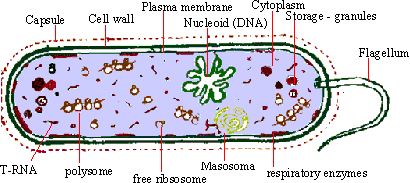Figure 14.8 Forms of Eubacteria
Shape and size : They are unicellular microorganisms of various shapes and accordingly, they are called cocci (spherical), bacilli (rod-shaped), spirilla (spiral) and vibrios (broken spirals or comma shaped).
Their sizes vary from 0.1m to 20 m in breadth and 0.2 m to 80 m in length.
Locomotion : They are generally non-motile,
but motile bacteria may have flagella at one end, at both ends, or
all around the cell.
Cell structure : Their cell wall contains peptidoglycan and muramic acid.
Their cytoplasm is without streaming movements and without endoplasmic reticulum. However, free ribosomes are present.
Mitochondria are absent but respiratory enzymes are located on the surface of mesosomes which are invaginations of plasma membrane.
Golgi complex and true plastids are absent. However,
photosynthetic bacteria show chromatophores containing bacteriochlorophyll
(e.g. purple-S-bacteria) or chlorobium chlorophyll (e.g. green-S-bacteria).
All three types of RNA are present.
Cells are prokaryotic, i.e. without nuclear membrane,
nucleoplasm and nucleolus. They contain a single molecule of circular
double stranded DNA attached to the plasma membrane at one point.
Respiration : They are aerobic or anaerobic.
Nutrition : They show autotrophic or heterotrophic
mode of nutrition. Autotrophic bacteria are of two types, viz., photosynthetic,
which produce food material by using light energy (e.g. purple-S-bacteria
and green-S-bacteria), and chemosynthetic which produce food material
by using chemical energy which is derived by oxidizing certain inorganic
compounds (e.g. Nitrosomonas, Nitrobacter). Heterotrophic bacteria
are saprophytic, growing on dead and decaying organic matter, or parasitic,
growing in living plants and animals, including humans. The parasitic
bacteria may be pathogenic, causing diseases (e.g. Xanthomonas
citri, Diplococcus pneumonae) or non-pathogenic, which usually
form a symbiotic association with their hosts (e.g. Rhizobium,
fixing nitrogen in leguminous plants, and cellulose-digesting bacteria
in ruminant stomachs).
 Click here to enlarge
Click here to enlarge
Figure 14.9 Cell Structure of bacterium
Staining : Those bacteria which retain Gram
stain are called gram-positive bacteria, (e.g. Streptococcus)
while those which do not retain the stain are called gram-negative
bacteria, (e.g. Escherichia coli).